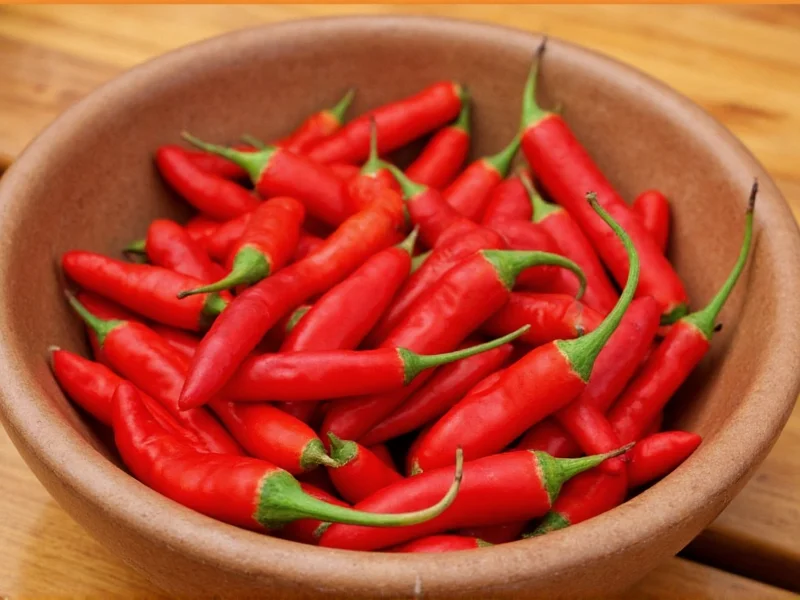Understanding the precise heat range of Fresno chiles helps home cooks and culinary professionals make informed decisions when selecting peppers for recipes. These versatile chilies offer more complexity than their heat rating alone suggests, with flavor profiles that evolve as they mature from green to red.
Understanding Fresno Chile Heat Measurement
The Scoville scale remains the standard for measuring chili pepper heat, quantifying capsaicin concentration in Scoville Heat Units (SHU). Fresno chiles occupy a middle ground in the pepper spectrum, making them accessible to most palates while still providing noticeable warmth. Their heat range of 2,500-10,000 SHU means a single pepper can vary significantly in spiciness depending on growing conditions, maturity, and even individual variation within the same plant.
When comparing how hot are fresno chiles compared to jalapenos, the answer reveals an interesting overlap. While jalapeños range from 2,500-8,000 SHU, Fresnos extend slightly higher to 10,000 SHU. This means some Fresnos can surpass milder jalapeños, though they generally occupy similar heat territory. The perception of heat also depends on preparation method—seeds and membranes contain most capsaicin, so removing these reduces perceived spiciness regardless of pepper type.
Fresno Chile Heat Comparison Chart
| Pepper Variety | Scoville Heat Units (SHU) | Relative Heat Level |
|---|---|---|
| Fresno Chile (Green) | 2,500-6,000 | Mild to Medium |
| Fresno Chile (Red) | 5,000-10,000 | Medium |
| Jalapeño | 2,500-8,000 | Mild to Medium |
| Serrano | 10,000-23,000 | Medium-Hot |
| Cayenne | 30,000-50,000 | Hot |
Factors Influencing Fresno Chile Heat Levels
Several elements affect the actual heat you'll experience when using Fresno chiles:
- Maturity stage: Green Fresnos (harvested early) tend toward the lower end of the heat spectrum (2,500-6,000 SHU), while fully ripened red Fresnos develop more capsaicin (5,000-10,000 SHU)
- Growing conditions: Stressors like inconsistent watering or nutrient deficiencies can increase capsaicin production, making peppers hotter than average
- Individual variation: Even within the same plant, heat levels can differ significantly between peppers
- Preparation method: Removing seeds and white membranes reduces heat substantially, as these contain the highest capsaicin concentrations
When exploring fresno chile heat level scoville measurements, remember that these values represent potential ranges, not fixed measurements. A particular Fresno might test at 3,000 SHU one season and 8,000 SHU the next, depending on environmental factors.
Culinary Applications Based on Heat Profile
The medium heat level of Fresno chiles makes them exceptionally versatile in cooking. Their flavor profile combines moderate heat with grassy, slightly fruity notes that intensify as they ripen from green to red. Chefs appreciate how are red fresno chiles hotter than green varieties while offering deeper, more complex flavors.
For those wondering how to use fresno chiles in cooking, consider these applications:
- Green Fresnos work well in salsas, guacamole, and cream-based sauces where moderate heat is desired
- Red Fresnos add both color and warmth to tomato-based sauces, stews, and roasted vegetable dishes
- Thinly sliced Fresnos make attractive, flavorful garnishes for tacos, salads, and sandwiches
- They pickle beautifully, retaining crunch while absorbing flavors
Substitution Guidance for Different Heat Preferences
When your recipe calls for Fresno chiles but you need alternatives, understanding fresno chile vs serrano heat differences helps you select appropriate substitutes:
- Milder option: Poblano peppers (1,000-2,000 SHU) provide similar flavor with less heat
- Closest substitute: Jalapeños offer nearly identical heat range with slightly different flavor notes
- Hotter alternative: Serranos (2-3x hotter) work when you want more intense heat with similar flavor profile
- Dried option: Guajillo peppers provide comparable heat with dried fruit notes
For those specifically seeking substitute for fresno chiles mild preparations, consider using half the amount of jalapeño or removing all seeds and membranes from standard substitutes. Remember that cooking methods affect perceived heat—roasting can mellow flavors while pickling often intensifies perceived spiciness.
Growing Tips for Controlling Heat Levels
Home gardeners curious about fresno pepper spiciness scale variations can influence heat through cultivation practices:
- Consistent watering prevents stress-induced heat spikes
- Adequate spacing between plants reduces competition stress
- Harvesting earlier (green stage) yields milder peppers
- Allowing full ripening to red stage develops more complex flavors and slightly higher heat
- Soil with balanced nutrients produces more predictable heat levels
Unlike some chili varieties, Fresnos don't dramatically increase in heat throughout the growing season. Their moderate heat makes them reliable for gardeners seeking consistent results without extreme spiciness.
Final Considerations for Using Fresno Chiles
Fresno chiles occupy a sweet spot in the pepper spectrum—hot enough to provide noticeable warmth but mild enough for regular use without overwhelming other flavors. Their heat level makes them accessible to most palates while still offering culinary interest. Whether you're exploring how hot are fresno chiles for recipe development or garden planning, understanding their variable but moderate heat profile helps maximize their culinary potential.











 浙公网安备
33010002000092号
浙公网安备
33010002000092号 浙B2-20120091-4
浙B2-20120091-4